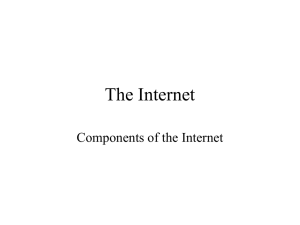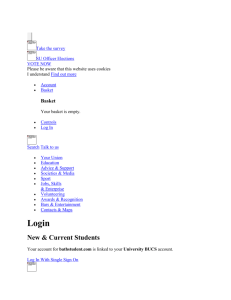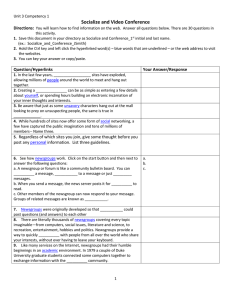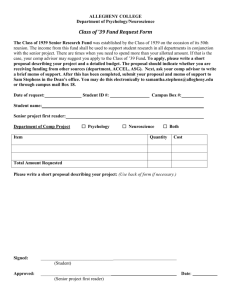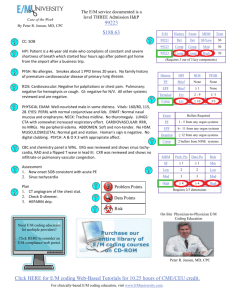Document 10508220
advertisement
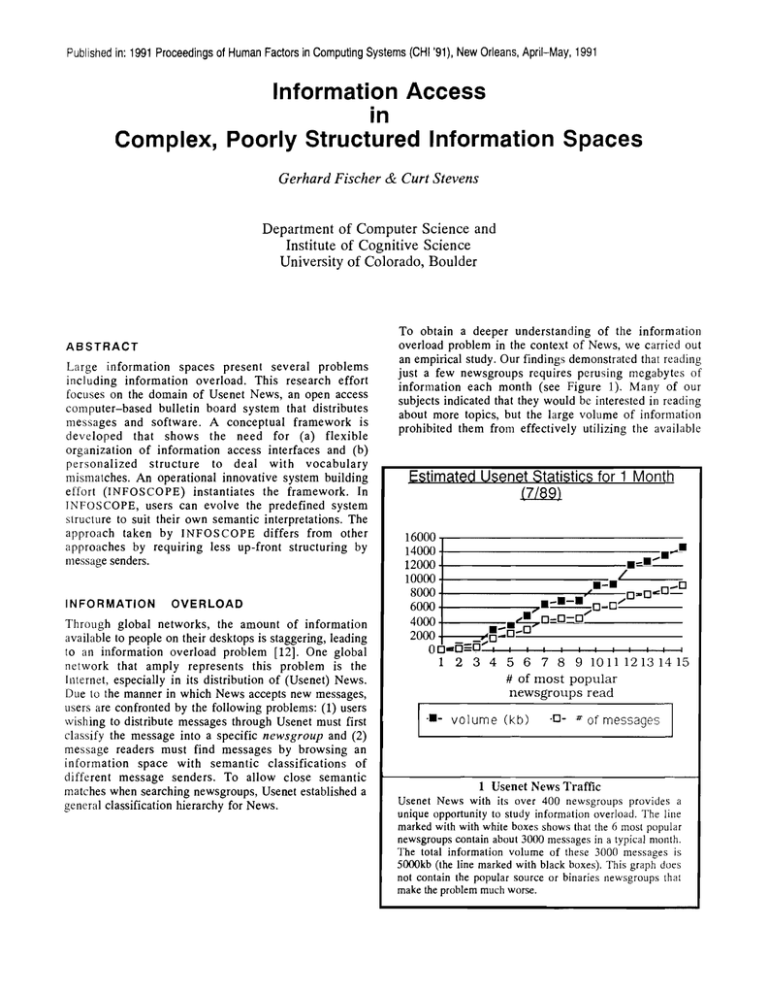
Published in: 1991 Proceedings of Human Factors in Computing Systems (CHI '91), New Orleans, April-May, 1991
Information Access
in
Complex, Poorly Structured Information Spaces
Gerhard Fischer & Curt Stevens
Department of Computer Science and
Institute of Cognitive Science
University of Colorado, Boulder
ABSTRACT
Large information spaces present several problems
including information overload. This research effort
focuses on the domain of Usenet News, an open access
computer-based bulletin board system that distributes
messages and software. A conceptual framework is
developed that shows the need for (a) flexible
organization of information access interfaces and (b)
personalized structure to deal with vocabulary
mismatches. An operational innovative system building
effort (INFOSCOPE) instantiates the framework. In
INFOSCOPE, users can evolve the predefined system
structure to suit their own semantic interpretations. The
approach taken by INFOSCOPE differs from other
approaches by requiring less up-front structuring by
message senders.
INFORMATION
OVERLOAD
Through global networks, the amount of information
available to people on their desktops is staggering, leading
to an information overload problem [12]. One global
network that amply represents this problem is the
Internet, especially in its distribution of (Usenet) News.
Due to the manner in which News accepts new messages,
users are confronted by the following problems: (1) users
wishing to distribute messages through Usenet must first
classify the message into a specific newsgroup and (2)
message readers must find messages by browsing an
information space with semantic classifications of
different message senders. To allow close semantic
matches when searching newsgroups, Usenet established a
general classification hierarchy for News.
To obtain a deeper understanding of the information
overload problem in the context of News, we carried out
an empirical study. Our findings demonstrated that reading
just a few newsgroups requires perusing megabytes of
information each month (see Figure 1). Many of our
subjects indicated that they would be interested in reading
about more topics, but the large volume of information
prohibited them from effectively utilizing the available
Estimated Usenet Statistics for 1 Month
(7/89)
.
._.L
16000 , . - - - - - - - - - - - - - - 14000+------------------------------ ~
12000 -+------------.-~-10000
_0
8000
o-~o~
' . - . - . 0-0-'----4000
~o;-_o--~o.__---------2000
.:~~-o~
_
.... 0
......
..
,
___________
OO·O=O-4I~~~4-~~-4--~~~~~
1 2 3 4 5 6 7 8 9 10 11 1213 14 15
# of most popular
1·.-
newsgroups read
volume (kb)
·0-
.#
of messages
1 Usenet News Traffic
Usenet News with its over 400 newsgroups provides a
unique opportunity to study information overload. The line
marked with with white boxes shows that the 6 most popular
newsgroups contain about 3000 messages in a typical month.
The total information volume of these 3000 messages is
5000kb (the line marked with black boxes). This graph does
not contain the popular source or binaries newsgroups that
make the problem much worse.
Lifecycle Stages
c:J
Issues
Actions
2 An Information Lifecycle
There are four basic stages in the life of a message. Within each stage there are several tasks and
decisions to be made. The arrows between stages in this diagram represent the processes involved in
transferring a message from one stage to the next.
Once a message is stored, its lifecycle doesn't end. When
users have questions (question time) they can access this
information. This process of taking a message from
question time to read time is called retrieval, and is
addressed in our research by the HELGON system [5].
Adding personal retrieval semantics at storage time helps
make retrieval easier.
information. This suggests that users need help finding
relevant information and supports the conclusion that the
critical resource is not the available information but the
human attention necessary to utilize that information [14].
One hypothesis behind our research is that by reading
selected newsgroups more efficiently, users can read more
newsgroups.
CONCEPTUAL
When users have a question but have not previously stored
any relevant information, they engage in a process of
discovery [13], in which a new message is sent as a request
for augmentation of one's own environment. Because the
process of discovery involves interaction with many agents
(the other users of Usenet News), it is highly unlikely
that any two identical queries will result in the same set
of answers. This makes the process of discovery quite
different from that of retrieval.
FRAMEWORK
An Information Llfecycle
Our work in developing systems that help with messages
indicates that messages travel through an information
lifecycle. As illustrated in Figure 2, when related
messages traverse the arc between send time (when
messages are created) and read time (when messages are
read) a conversation results. However, only some messages
are interesting over the long term, and those messages
traverse the arc between read time and storage time (when
messages are saved for later retrieval). Saving messages
indicates that those message topics are interesting.
The Four Stages Of Information Processing
Each stage represents several actions and issues. Send time
processing is the work users do to send a message. It ranges
from simply specifying a destination and subject (as in
UNIX e-mail), to coarse-grained categorization (as in
2
Another analysis is Moran's external-internal task
mapping analysis [10]. In this model the computer system
is viewed as "a conceptual world into itself." Moran's
analysis shows that in the process of design certain
conceptual mismatches arise between the system's internal
representations and the external reality of tasks and their
specifications in the user's domain of interest.
Usenet newsgroups), to fine-grained structuring of the
semantics of the message content.
Read time processing is the work users do in order to find
and read the information of interest. This ranges from
simply browsing the information space (like the UNIX
RN news reader), to writing specific rules to filter out
information that already includes sophisticated semantics.
The Information Lens
This system [9] addressed the overload problem in the
domain of electronic mail. There are differences between
the news and mail domains. For example, mail message
senders must specify a finite list of recipients and usually
know who these people are. News message senders,
however, know very little or nothing about who or how
many readers receive their messages. While this makes the
goals of INFOSCOPE and the INFORMATION LENS
different, the basic goal of filtering large numbers of
messages to find relevant information is shared by both
systems. The INFORMATION LENS allows message
senders to structure their messages. The message sender
selects templates representing a particular message type
and header components. Message readers write filters that
find messages matching certain structures. For example, a
student might write a filter to collect all "meeting
announcement" message types that contain a "professor"
type in the "From:" header line. This idea works well in a
small environment of users where standards and
expectations can be imposed, but it may not work well in a
global environment. It may also fail in environments
where people just want to get their work done [2]. The
reasons for this relate to the cost!benefit ratio as perceived
by the sender of messages [7]. The sender is not the reader,
and because adding structure helps the reader find the
message, there is no direct benefit to the sender by adding
that structure. Typical senders merely wish to write the
text of a message and send it. Because senders are often not
willing to provide extra structure [8], the INFORMATION
LENS allows users to define filters without templates,
using the text contained in header fields. Unfortunately,
this apparently bypasses the semi-structured message
templates already described and may force users to define
two sets of filters. The first set describes filters requiring
template components and the second describes those using
plain text since some messages won't contain template
components.
At storage time users have an opportunity to add retrieval
semantics to the message. This ranges from simply saving
all messages to a flat file or mbox (like many people use
UNIX e-mail), to adding coarse-grained semantics by
saving to a folder structure (like some people use UNIX
e-mail), to utilizing fine-grained semantics and saving to
an area that can be perused using rules.
Question time processing occurs when users need specific
information. To retrieve previously stored information
users must articulate a query, which ranges from simply
searching for text strings, to utilizing coarse-grained
semantics (like the UNIX e-mail folders), to utilizing
fine-grained semantics stored with the information. If no
information is already stored, users must engage in
discovery.
Situation and System Models
In addition to the information lifecycle, an analysis of the
situation and system models [3] supports this conceptual
framework. Users state their desires in the terms of their
current task, context or view of the world (the situation
mode!), whereas a computer system presents them with an
information space organized around someone else's view of
the world (the system model). For example, a user
interested in the language CLOS (common-lisp object
system) may be unable to find relevant messages because
they reside in the newsgroups comp.lang.lisp and
cu.cs.commonloops. There is no CLOS newsgroup, but the
user only knows that term (illustrating what Furnas [6]
calls the vocabulary problem). Our research investigates
various methods for bridging gaps between situation and
system models. In most approaches, users receive help in
expressing themselves in a system model, forcing them to
map their personal situation model to a more global
system model. This task consumes valuable cognitive
resources. The approach investigated through INFOSCOPE
is to design systems that learn about users and allow the
expression of structure in the users' own situation models.
The system model presented by INFOSCOPE can be refined
by users until it more closely matches their situation
models.
Our research is based upon the hypothesis that senders will
not expend the extra cognitive effort necessary to
carefully classify messages, but readers will expend a
limited amount of effort in restructuring because they
perceive a direct benefit (messages are easier to find) from
doing so. This is done by allowing readers to restructure
the information space according to individual semantics
when messages are read.
A similar perspective on this problem, the gulfs of
execution and evaluation, has been developed by Norman
[11]. The gulf of execution involves the translations from
one's goals to the physical system being used to execute
those goals. The gulf of evaluation represents the mapping
from the physical system, which has completed some
portion of the desired task, to the terms and expressions of
the goal as viewed by the user.
3
The RN Interface to Newsgroups
INFOSCOPE
•••
•••
1 unread article in alt.hypertext--read now? [ynq]
13 unread articles in alt.sources--read now? [ynq]
••• 1 unread article in boulder.general--read now? [ynq]
••• 2 unread articles in co.general--read now? [ynq]
••• 23 unread articles in comp.ai--read now? [ynq]
*•• 14 unread articles in comp.binaries.mac--read now? [ynq]
••• 9 unread articles in comp.cog-eng--read now? [ynq]
••• 99 unread articles in comp.langJisp--read now? [ynq]
••• 1 unread article in comp.mail.headers--read now? [ynq]
••• 6 unread articles in comp.newprod--read now? [ynq]
*.* 11 unread articles in comp.sources.games--read now? [ynq]
••• 30 unread articles in comp.sources.misc--read now? [ynq]
••• 1 unread article in comp.sources.unix--read now? [ynq]
••• 1 unread article in comp.sys.mac.digest--read now? [ynq]
... 289 unread articles in comp.sys.mac--read now? [ynq]
The INFOSCOPE project includes a system
implementation encompassing many of the
principles discussed earlier. This paper
describes three specific parts: (1) a graphically
based user interface for accessing News
messages, (2) virtual newsgroups, a method
for spanning the gaps between the situation
and system models in the News domain, and
(3) agents that address the problems created
by implementing virtual newsgroups.
Infoscope vs. Text-Based
Several interfaces to the News
space exist. The most common is
presents users with a succession
containing the names and
newsgroups (see Figure 3).
Interfaces
information
called RN. It
of text lines
status of
3 Text-Based Newsgroup Interfaces
Text-Based interfaces do not display the relationships between
newsgroups in the information space. Browsing in this type on
environment can be an arduous task.
cu.cs.gradtl
COIV>.b nart.s.fVC
COftp.$p.INC
CMp •• t.«iu
COl't{J • •
CM.p ... •
n
r4
-,...t$
4 Browser Tool
The Browser Tool allows users to peruse and learn the existing structure of baskets in INFOSCOPE. Messages within a basket
are also browsed in this tool. From here the user can click the mouse on objects to invoke reading, posting, or virtual structure
operations. Rectangular nodes are intermediate classifications and are associated only with basic actions such as "display
some children." Oval nodes contain messages and represent Usenet newsgroups. These are associated with operations such as
"browse messages," and "create virtual basket." The highlighted oval nodes are user-defined virtual newsgroups and
represent extensions to the Usenet structure.
4
have "Re: Re:" at the beginning of the subject line and so
on as the conversation flourishes.
An initialization file orders the presentation of
newsgroups, but RN provides no tools for managing this
file. Although this type of interface might be fine for
users who are experienced with the software and familiar
with the organization of the information space, it does not
illustrate this structure in an effective manner. The
INFOSCOPE user interface is a graphical one, which
represents the organization of the News information space
by displaying the newsgroup hierarchy on the computer
screen.
There are several advantages to displaying the structure of
messages in this manner. In the INFOSCOPE system
conversations may be treated as an object. This means that
operations such as "Save this conversation," can be used to
write all of the messages of a conversation to a file at once.
Saving subconversations is as simple as saving entire
conversations. For example, if someone responds to a
posting with a particularly interesting comment, a whole
new conversation may start within a conversation. This
conversation can be saved by clicking the mouse on its root
node.
The INFOSCOPE basket browser contains classifications,
newsgroups, or virtual newsgroups which requires three
node representations. In Figure 4 the comp and comp.lang
nodes serve to illustrate the structure of the information
space. The comp.lang.lisp node is a Usenet newsgroup and
the comp.lang.lisp.clos node is a virtual basket containing
selected messages filtered from the newsgroups
comp.lang.lisp and cu. cs. commonloops. Virtual
newsgroups represent the areas of keenest interest to the
individual user and will become the users' center of
attention. This reorganization of the information space
helps narrow the situation/system model gap by
presenting classifications based in user terminologies.
Virtual
Messages
In addition to browsing and manipulating the structure of
baskets in INFOSCOPE, users can use the message browser
pane of the browser tool to display and navigate through
the set of messages contained in a basket. The message
browser on the right side of Figure 4 shows messages from
the virtual basket comp.lang.lisp.clos.
In RN software, the lack of structure imposed
on logical collections of messages confounds
many novice users. Conversations are often
more than "one-shot" dialogs. When several
users post a response to a particular message,
those messages may each spawn
subconversations or threads. RN displays
messages in the chronological order in which
they arrive at an individual's computer.
Although the system provides a command for
scanning all messages with the same subject, the
structure of threads is lost in the ordering.
INFOSCOPE organizes messages into
conversations and threads. A conversation
consists of a message node, all responses to the
message in that node, and similarly all
responses to the responses until leaf nodes are
reached. This idea is demonstrated in Figure 4 by
the conversation about "Comparison of CLOS
and New Flavors." The two partially displayed
messages starting with "Re:", and attached to
the "Comparison ... " node, are responses to the
original posting. "Re:" stands for 'regarding'
and is placed in the subject line of a message by
the standard news software whenever a reply is
posted. Messages in response to a response wiII
Newsgroups
In order to browse virtual baskets, they must first be
created. This process takes place in the basket filter tool
(see Figure 5). To create virtual structure, users choose one
of the parents of the virtual basket, which can be either real
or virtual baskets. When users select either "Create
Virtual Basket" or "Edit Virtual Basket" they are taken
into the filter tool and presented with a partially filled
out filter. INFOSCOPE uses whatever information it has to
fill in the filter. When creating a new basket, it fills in a
default name for the new basket and the parent that was
used to enter the restructuring process. In the example of
Figure 5, users are editing the definition for the virtual
basket comp.lang.lisp.clos. Using this new virtual basket,
users have a repository for information about CLOS that is
displayed using the name semantically attached to that
information by the user who defined the basket. By
Filter MaKer
A
*
indicates that this field ftust be filled.
* Ba~ket
NaMe: COMpo lang. lisp.clos
Parent: cu.cs.coMMonloops
Parent: COMpo lang. lisp
Parent: 4 string
Include: subject: clos
Include: subject: pcl
Include: a h~ader line
Exclude: 4 header line
~
aborts,
~
uses these values
5 Defining Virtual Structure
The Filter Maker allows users to create and modify the filter
descriptions for virtual baskets. In this example. the virtual basket
comp.lang.lisp.clos is being edited. The basket inherits messages that
contain the subjects pel or e10s from the existing baskets
comp.lang.lisp and cu.cs.commonloops.
5
patterns. Agents post suggestions to the user that must be
accepted to be implemented. In INFOSCOPE, agents help
construct virtual filters and users critique those
suggestions, making them more accurate. This is easier for
users than forcing them to recall enough information to
define useful filters.
allowing individual users to define virtual baskets, one
global system model can be translated into individual
situation models.
Agents
Unfortunately, this kind of system model personalization,
like any structure modification task, is very difficult. The
structure must be based on an analysis of user behavior
patterns of which users are not aware. A computer system
can assist users in analyzing this behavior based on certain
concepts of how users act, and can be used to assist
structure creation and modification. In INFOSCOPE, these
methods are called agents.
The mechanisms that agents use to carry out many of their
functions are loosely based on Anderson's Rational
Analysis of Human Memory [1]. His analysis leads to the
definition of several effects that help measure how
effectively the history of usage patterns predicts current
usage patterns, or the probability that an item is needed
given the history of need for such items. For this reason
agents keep track of numerous pieces of information about
system activities. The three effects that Anderson
discusses are frequency, recency, and spacing. Frequency
refers to the number of times an item is needed within a
specified period of time. Recency refers to the amount of
time elapsed since the last need for an item, and spacing
refers to distribution across time of the exposures to these
items. By holding certain factors constant in specific
situations, equations (power functions) are developed that
serve as predictors of the current need for an item that has
been needed in the past. For example, an item that has been
needed 10 times in the last month is more likely to be
needed now if its past exposures are distributed evenly
across the time span than if all of the past instances
occurred in the first three days of that month. Similarly, if
an item was needed once a long time ago the probability of
current need is less than that for an item that was used very
recently. These effects require agents to decay the value of
message topics over time when their frequency is low,
INFOSCOPE agents are collections of rule-based heuristics
that utilize information resulting from the analysis of
user behavior to make suggestions to the user. These
suggestions concern the future modification of the system
model that the agents deem necessary for proper evolution
of the structure. Users can then accept, reject, or modify
these suggestions, and evolution proceeds in this
cooperative fashion (see Figure 6). In addition, the agents
analyze suggestions that are rejected or modified so that
the user models can be appropriately adjusted. When a
suggestion is rejected, something should be done to ensure
that the same error in judgement is not included in future
suggestions. The agents that do this analysis of suggestions
and modification of other agents are called supervisory
agents. They do not modify what the agents do, but why
and when they do it. From the user's perspective, agents are
a feedback mechanism, helping the user modify the
displayed structure based on their own system usage
@
.........
1 - -_ _®_4
f
Isuggestion I
~@~,-~
----I~
6 A Group of Agents
At <D, the. user interacts with INFOSCOPE for a period of time that extends until agent Q) recognizes that the
user consistently reads .Iess than 15% of the available messages in a particular newsgroup. At this time agent
Q) tell~ agent <3l to begm gathering topics that are judged interesting and uninteresting by the user. When a
suffiCIent v?lume of data h~ been gathered, agent @ posts a suggestion to the user. (®) If the user accepts
the su~estlOn agent ~ contmues gathering topics for modifying filters in the future. If the user rejects the
suggestIon, ~gent (5) tnes to find out why and uses this information to modify agent Q). In this example the
user complams that the agent is too intrusive. It is modified so that it only reacts when the user reads 10%
or less of the messages in a newsgroup.
6
extend systems like the INFORMATION LENS because
those systems require non-trivial amounts of effort on the
part of message readers.
increase them when the recency is high, temper those
evaluations with analysis of the spacing effects and so on.
In INFOSCOPE, users get direct input into the analysis in
breakdown situations. If the system determines something
to be of interest and the user disagrees, a dialog ensues in
order to clear up the discrepancy.
Limitations
INFOSCOPE intentionally does not make any effort to
analyze the content of messages. Currently the system
analyses the content of the header fields of a message.
Because vocabulary in the header field may not match the
vocabulary of the message body, relevant messages may be
missed with filters. The framework behind INFOSCOPE
allows the addition of semantic knowledge and constraints
incrementally, but our current effort has not focused on
this direction.
INFOSCOPE agents monitor two general areas of system
usage. The first of these deals with the user's individual
preferences in daily operation of the system. This includes
which baskets should be initially displayed by default and
many other aspects of day-to-day operation. The second
aspect of system usage that agents will monitor is the
actual content of messages that are deemed interesting or
uninteresting. This task is a statistical one, requiring agents
to keep track of what users are reading and what they are
ignoring over long periods of time. This happens on two
levels. At the higher level the system monitors the
amount of interesting information found on a regular basis
within a specific basket. When the amount is too low,
agents suggest modifying the existing structure. At the
lower level, the topics covered by a message are retained in
order to build and evolve filters. From these two parts of
the user profile, INFOSCOPE agents learn about individuals
who use the system regularly.
DISCUSSION AND
FUTURE
INFOSCOPE's ability to define filters is currently
limited to a small subset of boolean logic, which limits
the expressiveness of the filters that can be constructed.
For example, a filter cannot target only messages with all
of the words Lisp, CLOS, and efficiency. It will find all
messages with any subset of those words.
Filters represent personal structure on top of messages,
allowing structure to be saved with the messages. In order
to support the full information Iifecycle (see Figure 2),
INFOSCOPE should be more tightly integrated with
HELGON. An integration effort that joins a retrieval
system that can utilize this structure, like HELGON [5],
would increase the power of both systems.
WORK
The information overload problems created by large
information repositories make it difficult for users to find
relevant information. Database query languages are only of
use in highly structured and homogeneous information
spaces. Usenet News is mostly explored with browsing
techniques. Another way to address the problem is
allowing users to send semi-structured messages.
Unfortunately, there are indications that users are
unwilling to put forth the necessary effort [8]. A new
approach to this problem is helping users design more
effective filters dynamically at read time. This shifts the
burden of the extra structuring to the person who most
benefits from this effort.
Future Work
An important next step is conducting a longitudinal study
in a naturalistic setting. We will do this first with a
sizable user community at our university. This initial
study will be carefully analyzed, and enhancements will
be incorporated in the system before distribution to a
number of other sites that have already indicated their
interest in using the system. We have defined a number of
objectives to be carefully monitored in the study, such as
how much virtual structure users of INFOSCOPE will be
willing to provide and whether the system will reduce
information overload by helping users focus on their
interests.
INFOSCOPE is a fully operational prototype implemented
on Symbolics Lisp machines. It eliminates a number of
drawbacks of RN as an environment to access large, poorly
structured information spaces. It replaces RN's teletypeoriented dialog with a state-of-the-art interface
incorporating modem user interface tools. It provides (1) a
global view of the information space, (2) support for
conversations, (3) filtering methods for personalization,
and (4) agents assisting in analyzing user behavior. An
important aspect of INFOSCOPE is that it operates on top
of the Usenet system.
Although we hope that agents will provide users with
relevant information for the construction of filters, we
will replace the current filter-making tool with a filter
design environment [4J.
ACKNOWLEDGMENTS
We wish to thank the other members of our research
project, especially Evelyn Ferstl, Peter Foltz, Scott
Henninger, Walter Kintsch, and David Redmiles with
whom we shared many discussions about the ideas and the
systems discussed in this paper. This research was
supported by Grant No. MDA903-86-C0143 from the
Army Research Institute.
INFOSCOPE can also be viewed as an extension to parts of
the INFORMATION LENS [9]. While INFOSCOPE does not
include a set of template types, it augments the users'
ability to define filters by introducing agents that help
create more effective filters. The techniques used can
7
[8]
REFERENCES
[1]
[2]
Factors in Computing Systems, CHI'89 Conference
Proceedings (Austin, TX); ACM: New York,
Anderson, J. R.; The Adaptive Character of Thought;
Lawrence Erlbaum Associates: Hillsdale, New
Jersey, 1990.
1989; pp 211-216.
[9}
Carroll, J. M.; Rosson, M. B.; Paradox of the Active
User; In Interfacing Thought: Cognitive Aspects of
Human-Computer Interaction; J. M. Carroll, Ed.;
The MIT Press: 1987; pp 80-111.
[3]
Dijk, T. A. v.; Kintsch, W.; Strategies of Discourse
Comprehension; Academic Press: New York, 1983.
[4]
Fischer, G.; McCall, R.; Morch, A.; Design
Environments
for
Constructive
and
Argumentative Design; In Human Factors in
1986; pp 1-8.
[10] Moran, T. P.; Getting into a System: ExternalInternal Task Mapping Analysis; In Hum a n
Factors in Computing Systems, CHI'83 Conference
Proceedings (Boston, MA); ACM: New York,
1983; pp 45-49.
[11] Norman, D. A.; Cognitive Engineering; In User
1989; pp 269-275.
Centered System Design, New Perspectives on
Human-Computer Interaction; S. W. D. D.A.
Fischer, G.; Nieper-Lemke, H.; HELGON: Extending
the Retrieval by Reformulation Paradigm; In
Norman, Ed.; Lawrence Erlbaum Associates:
Hillsdale, NJ, 1986; pp 31-62.
Human Factors in Computing Systems, CHI'89
Conference Proceedings (Austin, TX); ACM:
[12] Reddy, R.; Technologies for Learning; In Computers
New York, 1989; pp 357-362.
[6]
in Education: Realizing the Potential, Report of a
Research Conference; U.S. Government Printing
Furnas, G. W.; Landauer, T. K.; Gomez, L. M.; Dumais,
S. T.; The Vocabulary Problem in Human-System
Communication; In Communications of the ACM
Office: Washington, D.C., 1983; pp 49-60.
1987,30, 964-971.
[7]
Malone, T. W.; Grant, K. R.; Turbak, F. A.; The
Information Lens: An Intelligent System for
Information Sharing in Organizations; In Human
Factors in Computing Systems, CHI'86 Conference
Proceedings (Boston, MA); ACM: New York,
Computing Systems, CHI'89 Conference
Proceedings (Austin, TX); ACM: New York,
[5]
Mackay, W. E.; Malone, T. W.; Crowston, K.; Rao, R.;
Rosenblitt, D.; Card, S. K.; How Do Experienced
Information Lens Users Use Rules?; In Human
[13] Schwartz, M. F.; The Networked Resource Discovery
Project; In Proceedings of the IFIP XI World
Congress; San Francisco, California, 1989; pp 827832.
Grudin, J.; Why CSCW Applications Fail: Problems
in the Design and Evaluation of Organizational
Interfaces; In Office: Technology and People 1989,
4,245-264.
[14] Simon, H. A.; The Sciences of the Artificial; The
MIT Press: Cambridge, MA, 1981.
8
